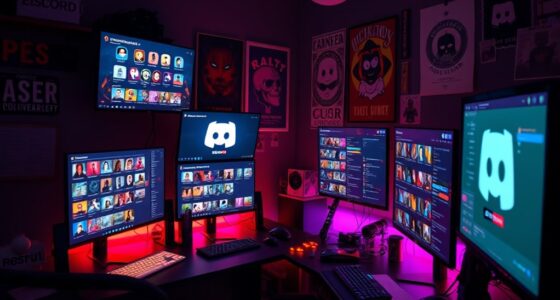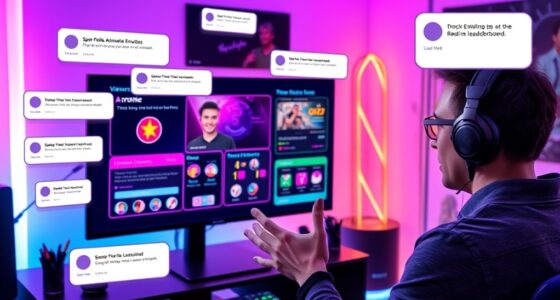To boost engagement in your official team apps, integrate gamification elements like badges, leaderboards, and rewards. These motivate employees by making tasks more enjoyable and recognizing achievements, fostering collaboration and friendly competition. Use clear goals, instant feedback, and fun challenges to keep everyone motivated. Monitoring progress and rewarding effort helps sustain energy and focus. Keep exploring how these strategies can transform your work environment for better productivity and teamwork.
Key Takeaways
- Gamification integrates rewards, badges, and leaderboards into team apps to boost engagement and motivation.
- It supports virtual teamwork through collaborative features and real-time feedback mechanisms.
- Visual cues like progress bars and achievement displays motivate continuous participation.
- Incentives such as recognition, gift cards, and development opportunities maintain long-term engagement.
- Monitoring tools and performance analytics help track progress, foster friendly competition, and address challenges effectively.
Understanding the Concept of Gamification in Workplaces
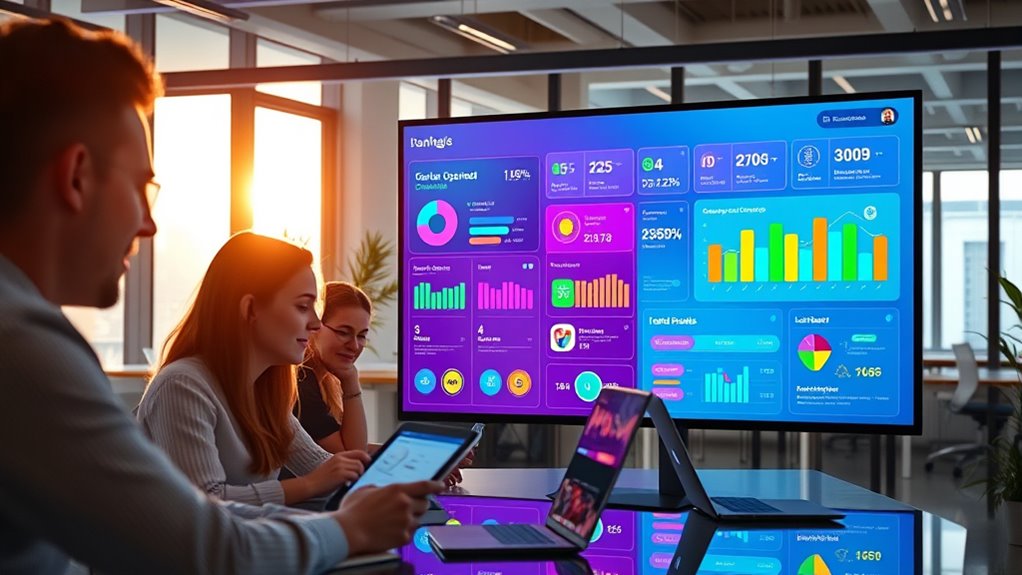
Gamification in workplaces involves applying game design elements to non-game settings, like team apps, to boost engagement, motivation, and productivity. When you incorporate rewards, badges, and leaderboards, you tap into employees’ natural desire for achievement and recognition. This approach can considerably enhance employee motivation by making tasks more enjoyable and rewarding. Additionally, gamification influences workplace culture by fostering a sense of teamwork, competition, and shared goals. It encourages employees to participate actively and feel more connected to their work environment. By integrating these game elements thoughtfully, you create a dynamic atmosphere that promotes continuous improvement and enthusiasm. Understanding how gamification shapes employee motivation and workplace culture helps you leverage its full potential in your organization.
Key Elements That Drive Engagement in Team Apps

Engagement in team apps hinges on several key elements that motivate users and keep them actively involved. One essential element is fostering virtual teamwork by creating opportunities for collaboration and interaction, making users feel connected regardless of location. Recognizing employee achievements through badges, leaderboards, or shout-outs boosts morale and encourages continued participation. Personalization also plays a critical role; when users can tailor their experience, they feel more invested. Clear goals and instant feedback help sustain motivation, giving users a sense of progress and purpose. Additionally, incorporating fun and competitive elements like challenges or rewards taps into users’ natural desire for achievement. These elements combined drive engagement, making team apps more effective in strengthening collaboration and maintaining active, motivated participants. Leveraging AI content clusters can further enhance user engagement by delivering targeted, relevant content that resonates with individual preferences and interests.
Benefits of Incorporating Gamification Into Daily Tasks
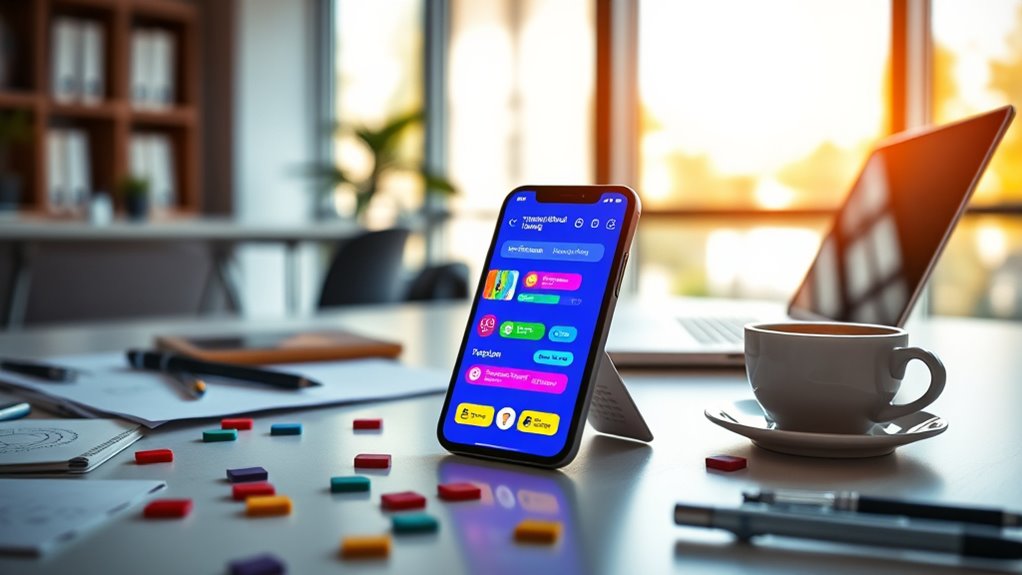
By adding gamification to your daily tasks, you can see a noticeable boost in engagement and motivation. This approach encourages you to stay focused and complete work more efficiently. Plus, it helps develop new skills while making routine activities more enjoyable. Integrating personal growth strategies into your gamified tasks can further enhance your development and long-term success.
Enhances Engagement Levels
When you incorporate gamification into your daily tasks, you often find yourself more motivated and focused. This boosts team motivation, making everyone more enthusiastic to participate and contribute. Gamification creates a sense of achievement through rewards, badges, or leaderboards, which keeps engagement high. It also encourages friendly competition, prompting team members to stay involved and committed. As employees recognize their progress and accomplishments, their sense of value grows, fostering loyalty and enthusiasm. These elements combine to make routine activities feel more dynamic and rewarding. Additionally, understanding family dynamics can help in creating a more supportive and cohesive team environment. When engagement levels rise, your team becomes more attentive and invested in their work, leading to a more energetic and committed work environment. Ultimately, gamification transforms ordinary tasks into motivating experiences, driving sustained engagement across your team.
Boosts Productivity Motivation
Incorporating gamification into daily tasks can substantially boost your team’s productivity motivation. When your team sees their efforts rewarded through points, badges, or leaderboards, it enhances employee engagement and fuels motivation strategies. This approach taps into their natural desire for achievement and recognition, making routine work more appealing. Imagine team members eagerly completing tasks, competing in friendly challenges, or striving for milestones. These visual rewards and social comparisons create a sense of progress and purpose. As motivation increases, so does focus and efficiency. Gamification transforms mundane activities into engaging experiences, keeping your team driven and committed to goals. Additionally, understanding the warning signs of a checked-out partner can help managers identify when team members may need additional support or engagement. Ultimately, it creates a positive cycle of motivation, productivity, and continuous improvement.
Encourages Skill Development
Gamification encourages skill development by turning everyday tasks into engaging learning opportunities. When you use game elements, team building becomes more effective as employees collaborate to complete challenges and earn rewards. This interactive approach helps you develop new skills and improve existing ones in a fun, motivating environment. As employees progress, they gain confidence and competence, which benefits the entire team. Additionally, incorporating gamification fosters employee recognition, making staff feel valued for their growth and achievements. This recognition boosts morale and encourages ongoing learning. By integrating gamified features into daily routines, you create a culture of continuous improvement, where skill development is both accessible and rewarding. Furthermore, understanding the Vortex concept can help align team goals with individual desires, leading to more harmonious and motivated collaboration. Ultimately, gamification helps you build a more competent, motivated, and cohesive team.
Popular Gamification Techniques Used in Team Platforms

You’ll notice that engagement badges and points are common tools to motivate your team and recognize achievements. Leaderboards and progress tracking add a competitive edge, encouraging everyone to improve and stay involved. These techniques make tasks more interactive and rewarding for your team members. Incorporating elements like music therapy into team activities can further enhance emotional well-being and foster a positive environment.
Engagement Badges and Points
Engagement badges and points are among the most effective gamification techniques used in team platforms to motivate participation. They leverage a well-designed badging system and point accumulation to recognize your efforts. When you earn badges, it’s like accessing digital trophies that showcase your skills and contributions. Points accumulate as you complete tasks, participate in discussions, or help teammates, fueling your sense of achievement. Visual cues, such as shiny badges or progress indicators, make your progress tangible. These elements encourage consistent engagement by rewarding your involvement. They also foster a sense of friendly competition and personal growth. Imagine a virtual badge gallery highlighting your accomplishments or a point tally motivating you to do more—these techniques turn everyday tasks into rewarding challenges. Additionally, understanding potential pitfalls in adopting new payment technologies can help teams stay secure and compliant while implementing gamification features.
Leaderboards and Progress
Leaderboards and progress tracking are powerful tools that boost motivation by providing clear benchmarks of your performance. By implementing effective leaderboard strategies, you can foster healthy competition and enhance engagement within your team. Seeing your rank rise or fall encourages continuous effort and goal-setting. Progress visualization makes it easy to understand your development over time, highlighting strengths and areas for improvement. These features create transparency, making achievements tangible and motivating you to stay committed. Whether it’s a real-time leaderboard or a visual progress bar, these tools keep you focused on your objectives. Ultimately, integrating leaderboards and progress tracking into your team app helps maintain momentum, encourages accountability, and drives collective success. As a best vacuum expert, I can tell you that effective filtration systems can similarly boost your home’s air quality by clearly demonstrating your cleaning progress and motivating you to maintain a healthier environment.
Selecting the Right Rewards and Incentives
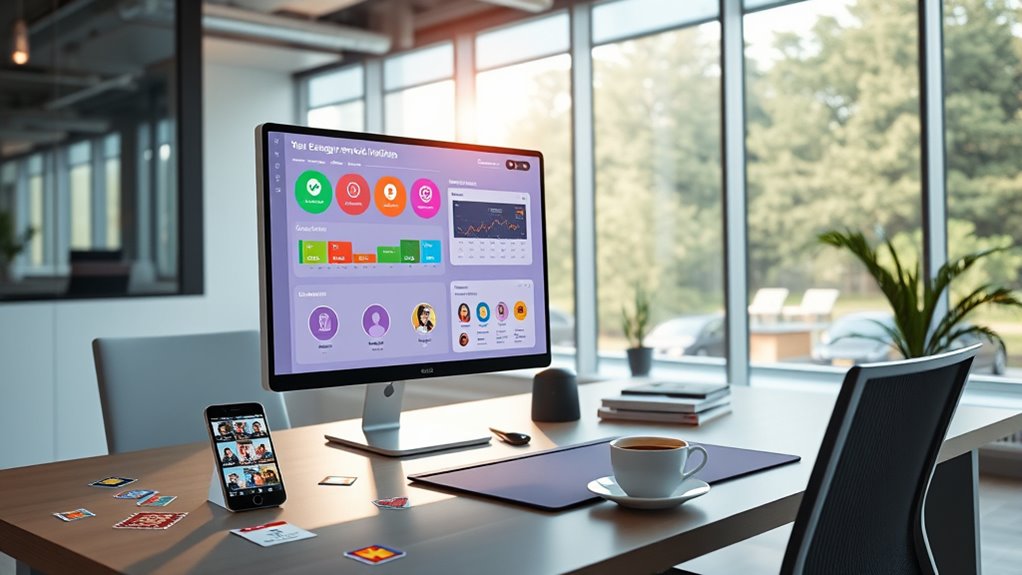
Choosing the right rewards and incentives is crucial to motivating team members and sustaining engagement in your app. Your goal is to select incentive types that resonate with your team, encouraging continued participation. Effective reward selection considers what truly motivates your team, whether it’s recognition, tangible rewards, or growth opportunities. Consider these options:
Choosing meaningful rewards keeps your team motivated and engaged long-term.
- Public recognition that boosts morale and fosters camaraderie
- Gift cards or bonuses for immediate, tangible motivation
- Extra time off or flexible schedules as valuable perks
- Professional development opportunities that support career growth
- Incorporating candy into reward schemes can add a fun and memorable element to incentive programs.
Designing Challenges and Goals to Boost Motivation

Designing effective challenges and goals is essential for maintaining motivation and encouraging ongoing participation in your team app. By applying principles from motivational psychology, you can craft challenge design that resonates with users’ intrinsic drives. Clearly defined, achievable goals give team members a sense of purpose and progress, fueling their engagement. Break larger objectives into smaller, manageable tasks to sustain interest and prevent frustration. Incorporate variety to keep the experience fresh, and set milestones that offer a sense of accomplishment. Remember, well-designed challenges tap into users’ desire for mastery, recognition, and social connection. When you align challenges with motivational psychology insights, you create an environment where team members stay motivated, participate actively, and feel valued for their contributions. Providing meaningful feedback reinforces positive behaviors and encourages continued effort.
Tracking Progress and Providing Real-Time Feedback
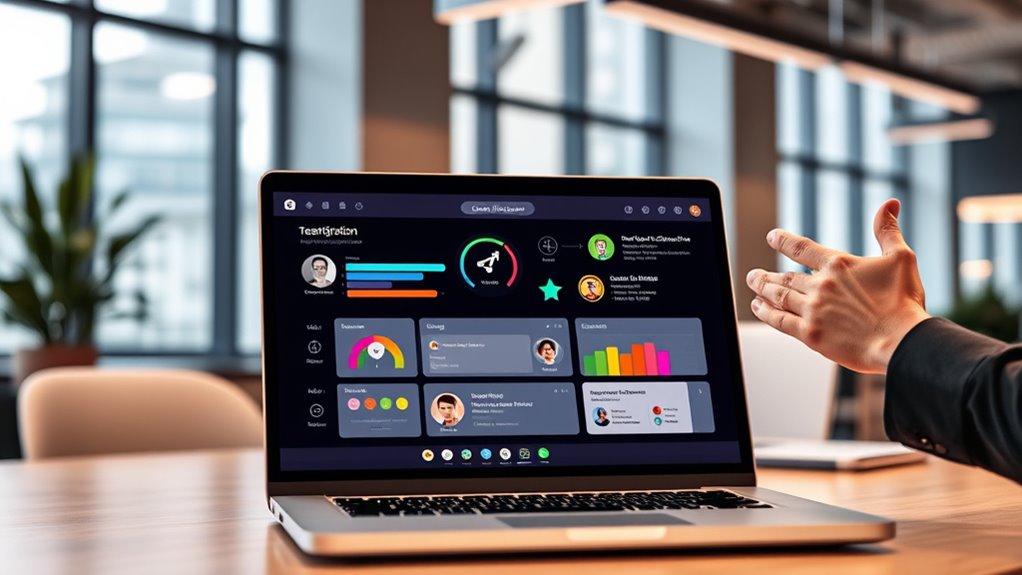
Tracking progress and providing real-time feedback are essential for keeping team members engaged and motivated throughout their tasks. In virtual teamwork, instant updates foster a sense of achievement and clarity, encouraging continued effort. When feedback is timely, you can quickly recognize employee contributions, boosting morale and reinforcing positive behaviors. Visual dashboards display real-time stats, making progress easy to monitor at a glance. Notifications highlight milestones, keeping everyone informed and focused. Leaderboards showcase top performers, inspiring healthy competition and immediate recognition. By integrating these features, you create an environment where team members stay aligned, motivated, and appreciated, ultimately enhancing productivity and collaboration. Additionally, implementing performance tuning techniques can optimize overall team efficiency and responsiveness. Real-time feedback ensures no one falls behind, keeping your virtual team dynamic and driven.
Overcoming Challenges and Potential Pitfalls
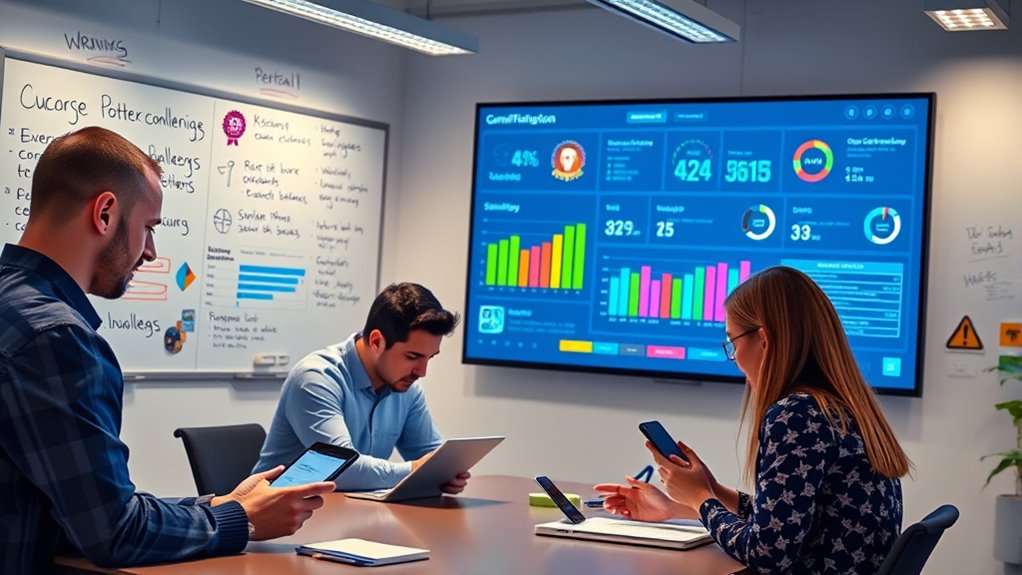
Implementing gamification in team apps can introduce challenges, such as fostering unhealthy competition or overwhelming users with too many notifications. To promote positive virtual team building, you need to carefully balance game mechanics to encourage collaboration rather than rivalry. Overemphasizing leaderboards may lead to demotivation or resentment, so incorporate features that highlight employee recognition instead. Be mindful of notification overload, which can cause notification fatigue and reduce engagement. Guarantee the gamification strategy aligns with your team’s culture and goals, avoiding gimmicks that feel superficial. Regularly gather feedback to identify and address potential pitfalls early. Additionally, understanding how greenhouse design can influence team dynamics helps create a more harmonious environment. By focusing on creating an inclusive environment that emphasizes recognition and teamwork, you can overcome challenges and maximize the benefits of gamification.
Case Studies: Successful Gamification Implementations
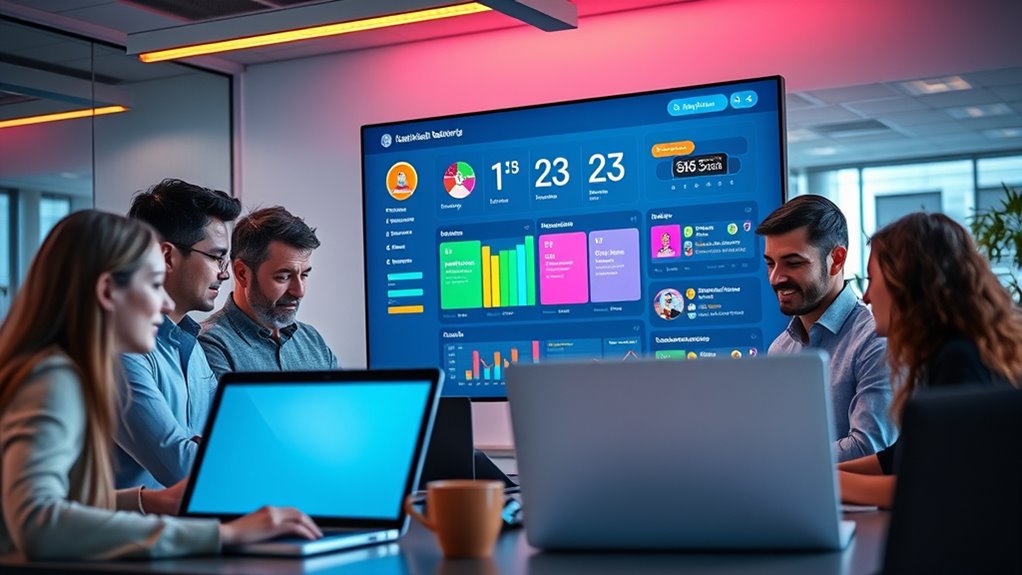
Real-world examples highlight how organizations have successfully harnessed gamification to boost engagement and teamwork. For instance, a company improved employee recognition by implementing a points system that rewards collaboration and innovation. In another case, a team app used game design elements like badges and leaderboards to motivate staff and foster friendly competition. A retail chain incorporated gamified training modules, making learning more interactive and effective. Additionally, a tech firm introduced challenges aligned with project goals, encouraging employees to participate actively. These implementations demonstrate that well-designed gamification fosters motivation, enhances communication, and creates a sense of achievement. For example, integrating game mechanics can significantly enhance user engagement and participation. When tailored with effective game design, these case studies show how gamification drives tangible results in workplace culture.
Future Trends in Gamified Workplace Collaboration

As technology continues to evolve, the future of gamified workplace collaboration is poised to become more immersive and personalized. Virtual reality will enable you to engage in realistic, interactive environments, making team training and meetings feel more dynamic. Artificial intelligence will tailor experiences to your individual preferences, providing customized challenges and feedback that boost motivation. Expect AI-driven analytics to identify collaboration patterns, helping you optimize team dynamics. These innovations will foster deeper engagement, streamline communication, and enhance productivity. You’ll work in virtual spaces that adapt to your needs, making collaboration more effective and enjoyable. As these technologies integrate seamlessly into official team apps, you’ll experience a more connected, efficient, and motivating workplace environment.
Frequently Asked Questions
How Do Companies Measure the ROI of Gamification Efforts?
You measure the ROI of gamification efforts by analyzing performance metrics and engagement analytics. Track improvements in productivity, task completion rates, and goal achievements to see tangible results. Use engagement analytics to gauge how actively your team participates and stays motivated. Comparing these data points before and after gamification implementation helps you determine its impact. Ultimately, a positive shift in these metrics indicates a successful investment in engaging your team effectively.
What Privacy Concerns Arise With Tracking Employee Activity?
When tracking employee activity, you should consider privacy concerns like employee surveillance and data security. Monitoring can make employees feel watched, leading to trust issues. Ensuring data security protects sensitive information from breaches, while transparent policies help maintain trust. You need to balance productivity goals with respecting privacy, making sure tracking practices comply with laws and respect individual rights. This approach fosters a safe, respectful workplace environment.
How Can Gamification Be Adapted for Remote Teams?
You can boost remote engagement by adapting gamification strategies for virtual teams. Use virtual rewards like badges or points to motivate employees and make collaboration fun. Incorporate challenges or leaderboards to encourage participation without feeling invasive. Regularly update activities to keep things fresh and inclusive. By doing so, you create a lively, interactive environment that keeps remote team members connected and motivated, ultimately enhancing productivity and morale.
Are There Industry-Specific Gamification Strategies for Team Apps?
You’re wondering if industry-specific gamification strategies exist for team apps. Yes, sector-specific tactics can boost engagement by aligning rewards and challenges with your industry’s unique needs. Customizing features through industry customization guarantees relevance, motivating your team effectively. For example, sales teams may benefit from leaderboards, while creative teams might prefer collaborative challenges. Tailoring these strategies helps you foster motivation and improve productivity across different sectors.
What Are the Best Practices for Avoiding Gamification Burnout?
Think of motivation maintenance as tending a delicate garden—you need to water it regularly to prevent burnout. To keep engagement strategies fresh, mix things up with varied challenges, recognize achievements, and set realistic goals. Don’t rely solely on rewards; foster a sense of purpose and community. This way, you’ll prevent burnout, keep spirits high, and guarantee your team stays energized and motivated without feeling overwhelmed.
Conclusion
Just like a compass guides explorers through uncharted waters, gamification steers your team toward engagement and success. By embracing these strategies, you’re not only orienting daily tasks more effectively but also inspiring your team to reach new heights. Remember, the true treasure lies in motivated, connected, and thriving collaboration. Keep steering with purpose, and watch your workplace transform into a vibrant landscape of achievement and innovation.


